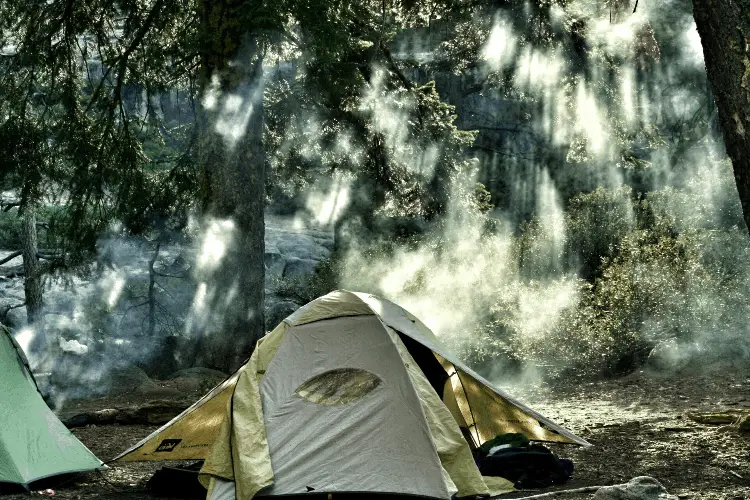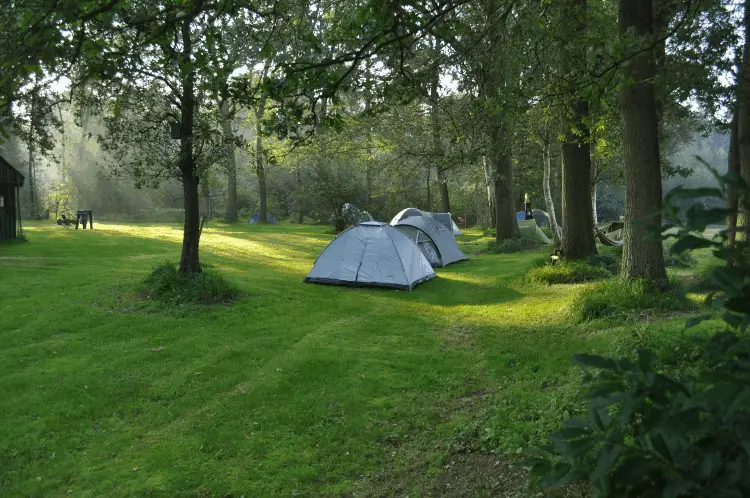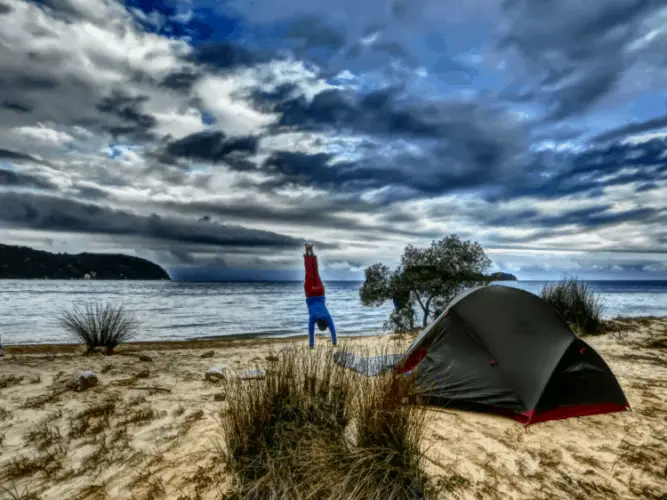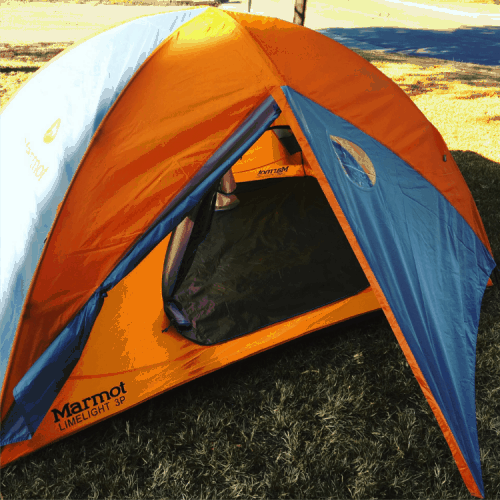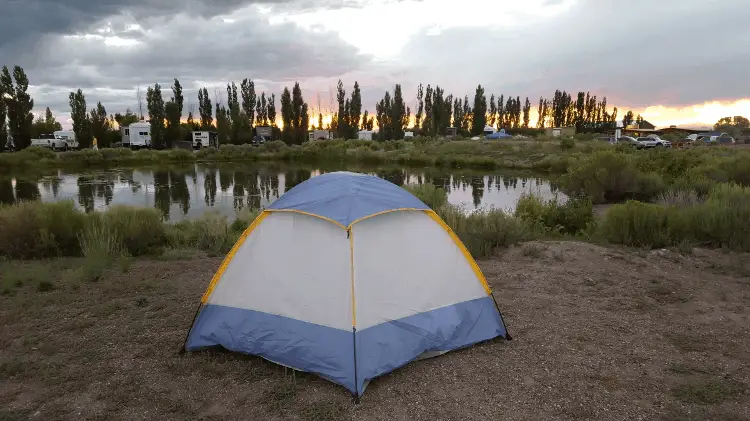How To Blackout A Tent: 9 Proven Tricks That Work
Have you ever been woken at 5 am by the morning sun lighting up your tent?
When sleeping in a tent, you are at the mercy of the sun. You don’t have blinds you can pull down to keep it dark for sleeping.
The lack of light blockage can be a problem in the summer as it gets dark late, and the sun comes up early. If you are in the far north, the sun can be up for over 20 hours a day at the peak of summer, making this problem even worse.
The key to a good night’s sleep in summer is knowing how to blackout a tent. Blacking out a tent is the process of minimizing external light coming in.
We cover nine of the most effective ways to blackout your tent, including:
- Sleep masks
- Picking a shadier tent location
- Using a tent with a Dark Room technology
- Using light blocking fabrics
- Blacking out only the bedroom pod
- Using reflective blankets
- Setting up your tent to face West
I’ve used all the above methods to blackout my tent many times. So, if you want to learn these insider tips and spend some cool time in your tent, read on.
Let’s get to it.
Pros of blacking out a tent
Sure enough, there are pros and cons of having a blackout tent. You need to be aware of them.
Let’s start with some pros first.
- Darker for a better night’s sleep
- Often quieter, so good in noisy areas
- More privacy
- Cool mornings as the sunrays are obstructed from penetrating your tent
Cons of blacking out a tent
Here are the major ones that I’ve found after sleeping many nights in a blackout tent.
- Usually hotter, which might make sleep difficult which is not fun at all
- You aren't as aware of your surroundings, so not ideal in bear country
- Adds weight to your system. Less than desirable if on foot.
9 Techniques to Blackout your Tent
Here are some tips and tricks to obtain a blackout tent based on years of experience.
#1 Wearing a blackout eye mask when sleeping
The simplest way to keep the brightness out of your eyes is with a sleep mask. This way, you don't affect anyone else in the tent if they don't want it dark.
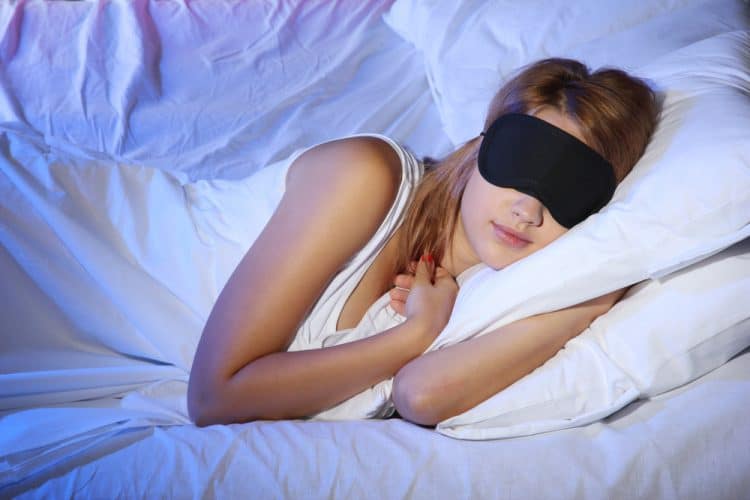
Using a sleep eye mask is often the easiest way of blocking the sunlight.
We can trick our brains pretty easily. With your eyes covered, your brain registers it as night, making it easier to sleep even during the day.
Besides a commercial sleep mask, you can also use buffs, hats, or a bandana to cover your eyes. You can even use your sleeping bag for that! And you don't need a dark tent for that. Even such tents can't guarantee complete darkness.
#2 Using a blackout liner
To have a dark tent, using a blackout liner is a genuine way of achieving this and protect yourself from the rising sun.
Such material can successfully block light.
To use a blackout liner, cover the inside of the tent with a black, light-absorbing material. That's a pretty neat way to make your tent a blackout tent.
You can attach blackout material to any hanging points your tent may have inside or drape it over the bug netting before putting it on the rainfly. You can just spread it like a regular mosquito net.
How you connect the blackout panels will depend on your tent and how often you expect to use them.
When planning out how to attach the blackout liners, keep in mind the airflow of your tent. Adding material can block the natural airflow leading to increased heat or condensation. That’s even if you use a tent for hot weather.
A method I've seen on a friend's tent his family uses for car camping was stitching on velcro strips inside the blackout tent on the bug screen.
He attached the opposite pieces to the blackout material. When he wanted to use the darkening panels, he just had to put them onto the velcro.
To improve ventilation, he would often just put the covers on the side of the tent facing east, as that is the direction the sun rises.
You can buy this type of material from fabric stores or online. For camping use, a synthetic material that dries quickly would be our recommendation, as it will handle any condensation or moisture that may make it into your tent.
Many tent companies may tell you more about what kind of black liner to use and how to use it.
Draping the exterior of the tent with a blackout fabric
This is a proven technique to black out your tent and create a shield against the incoming light.
It involves covering part or all of your tent with an opaque material. And you don't have to touch the inner tent.
Since it is being done on the outside, this material should be waterproof, besides being able to protect you from the rising sun.
A simple solution would be to drape your rainfly with an inexpensive plastic tarp. While easy to do, it will make your tent warmer. But it's an effective way to blackout a tent.
Another option would be to suspend the tarp over your tent, which would allow air movement.
To set up the tarp in this manner would require cords, tent stakes (knowing how to use them will help), and possibly some poles to suspend it if you don't have nearby trees.
A simple lean-to style with the side anchored to the ground facing the east will block most of the morning sun from lighting up your tent. It will also keep the sun from warming up your tent, which can help make sleeping more comfortable.
The cheaper plastic tarps with grommets on the edges are available in various sizes, so you should be able to find one that will be adequate to cover your blackout tent.
The plastic tarp is well suited to this, as they are usually in blue or camouflage and block almost all light. The problem with these tarps is the grommets can tear out if you experience high winds.
You can use the lighter-weight nylon tarps, but they must be a dark color to block much light.
My light olive-green tarp passes a lot of light through, while my dark green version of the same fabric blocks almost all light.
As the previous method, though, this one also imposes the risk of trapping the hot air inside the tent.
#4 Pitching your tent in a shadier location
If you don't want to wake up in your tent immediately after the sun rises, this is a cool method.
Instead of using a tarp to cover your blackout tent, look to natural sunblocks. Things tend to work in balance. You can simply use shade to blackout a tent.
In summer, the sun is out longer, but this is the time of year that the trees have all of their leaves, so it’s easier to find a shady spot to set up your tent.
Since you usually set up camp later in the day, keep in mind where the sun will come from first thing in the morning.
In the northern hemisphere, the sun will rise slightly south of due east. So, you might be in the sun at the end of the day, but if you have chosen the right spot, you will be in the shade when the sun comes up.
If the forest is dense enough, it can seem like a night in your tent in the middle of the day due to the lack of light making it through the tree cover.
Pitching your tent under dense foliage is a genuine way to make your tent darker. This will also keep the internal temperature cool.
Anytime you are setting up camp near trees or in the forest, do a thorough inspection of the surrounding trees.
Look for any dead trees or dead branches caught in the canopy that could fall on you. The wind picks up at night and can cause trees or branches to fall. Just make sure they don't fall on you.
#5 Use a tent with a dark color
Light colors will allow more light to pass through, so that a darker tent will block more light coming from the rising sun.
So you already can buy directly a blackout tent, so to speak. Many tent companies offer such.
If you are in the market for a new tent and have problems sleeping due to the light level, then the color choice can help.
If you are looking for a tent for car camping, it is pretty easy to find dark tents as almost all tent companies offer such.
However, most lightweight backpacking tents tend to be in light or bright colors. That’s the case with stargazing ones too.
Tactical or military tents are usually in darker colors since they aim to blend in with the surroundings.
#6 Blackout only the bedroom pod
This is another easy method to blackout a tent and you don't actually need to blackout the entire tent but just the sleeping space or the so called bed pod.
If you have a tent with a separate sleeping area (bed pod) or it’s large enough to divide up, you can just blackout that area and easily obtain a blackout tent.
This approach will tend to be aimed at car camping since backpacking tents are too small to have a dedicated sleeping area.
Using the same blackout fabric that we suggested for making blackout panels, you attach them inside the sleeping area.
If you set your tent up with the correct orientation, a dark curtain of fabric blocking you from the sun's direction will do a lot to keep your sleeping area dark and make your tent darker.
#7 Use Reflective blankets
A simple method that will block out a lot of light and blackout a tent is to use a reflective survival blanket.
Reflective blankets are a great blackout material. There are several ways to set it up depending on the size of the blanket you have and its attachment points.
If you use the standard lightweight space blanket, you can place it over the bug netting in your tent before installing the rain fly.
Reflective blankets can be cooler than blackout panels, as they reflect some of the heat away (as well as the direct sunlight) from the tent and don't insulate as much. And it will surely make your tent darker.
By using a reflective tarp with grommets or tie-out points, you can mount it vertically to trees or poles to act as a sun blocker. You will need some cords and tent pegs if you want it to be free-standing. I have mounted a reflective tarp like this facing the east, blocking the morning sun and serving to block the wind.
Aim the reflective side away from your tent. The advantage of this method is it doesn't insulate your tent making sleep more comfortable. The blocking of the morning sun will help keep the sun from warming your tent, thus making you enjoy your camping trip even more.
Another similar method is to use light diffusing emergency blankets.
#8 Set up your tent to face west
This is yet another easy technique to blackout a tent and have a cooler camping trip. And you don't need a blackout material or your tent to have a dark room technology. More on that later.
If you are sleeping with the vestibule of your tent (an important part of any tent) open to increase airflow, make sure to set it up with the opening facing west. And as we know, the sun rises from East.
Doing this will have the sun hit the back of the tent and not come through the open front door.
The best part about this method is that you can just use your existing tent. No need to buy additional stuff.
Sure enough, it will help if you set up your tent on a shady spot so that it will be hidden from the bright sunlight.
For maximum result, you can even choose to sleep on the west side.
When you set up your tent in this way, your tent will still get hit by the sun, but if you combine it with something to the east to block the early morning light, you will increase the amount of relative darkness you have to sleep.
Also when choosing a campsite, avoid sites with severe light pollution at night. Many campsites with light pollution have lanterns, multiple campfires, artificial lights, etc. So staying away from campsite with lots of light pollution makes sense
#9 Get a tent with darkroom technology.
This method doesn't allow you to use your existing tent.
If you want to skip the DIY approach to blackout a tent, you can just buy a tent with Darkroom technology, such as the Coleman Darkroom series. These are quite popular blackout tents that have blackout materials.
In that way you won't be bothered every morning when the sun rises too early. Your entire tent will be blackened.
Such dark room technology blocks 90 percent of the sun, while also not heating up as much as a regular tent. In fact, they provide quite good air circulation.
Isn't that what we need for comfortable sleeping?
Some even have multiple rooms with only the bedroom pod having the technology.
We have used some of Coleman's dark room tents and found them as really efficient blackout tents.
Watch the video below!
You are ready to go as soon as you set it up and don't need any extra gear by getting a Darkroom tent.
Coleman blackout tents are known for being affordable but aren't the lightest options, so they aren't the best for backpacking.
If you want to take it to the next level, consider Coleman's Blackout Bedroom sleep system. It's even better than a tent with a dark room technology. And they have a model with multiple rooms.
These large tents have a blacked-out sleeping chamber that blocks 98 percent of light transmission.
If you are car camping or going to a festival where you want lots of room and don't have to carry the tent in your pack, this line of tents offers comfort and ease of setup in addition to the darker sleeping area.
The Coleman Weathermaster Air is a favorite of ours with a frame that inflates rather than using poles. The inflatable arches make set up with one person a breeze.
The Weathermaster is available in 4-, 6-, or 8-person capacity to suit just about any family.
Conclusion
I hope now you know how to blackout a tent.
With several options to choose from, you should find an excellent way to keep your tent dark enough for a good night's sleep.
I'm a minimalist, so I usually use a Buff over my eyes, but when car camping at music festivals or other busy events, we often put up tarps as screens to make the tent darker and create some privacy.
My partner always brings her sleep mask from home, which works well for her, as it is what she sleeps with every night.
Try a few methods to see what works best for you. We all have different camping scenarios that might benefit from one way over another.
Winston Endall
Having worked in the outdoor, fitness, and cycling industry his whole life, Winston brings a wealth of real world knowledge on the topics. Rock climbing, backpacking, cycling and wilderness survival are his life. As both an athlete, coach, and outdoor educator, his practical experience translates into his writing to help people better pursue their outdoor passions. Read more about Winston here.


